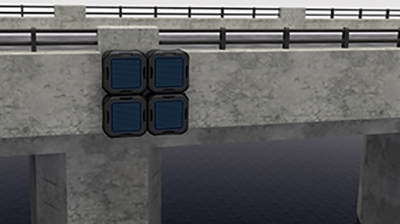Cosmic ray measurements could help extend lifespan of UK bridges
07/01/2025
The University of Glasgow, a major research-led university, is leading a groundbreaking initiative to use cosmic rays as a tool for assessing the structural integrity of the UK’s ageing transport infrastructure. Spearheaded by Dr David Mahon from the School of Physics & Astronomy, the project has secured £459,000 in funding from UK Research and Innovation (UKRI)’s Science and Technology Facilities Council (STFC). This research aims to significantly lower the cost and environmental impact of maintaining road and rail bridges by enabling early detection of structural issues.
Dr Mahon’s expertise lies in muography, a cutting-edge technique that leverages cosmic ray interactions to generate detailed 3D images of structures. Cosmic rays, upon colliding with atmospheric gases, release high-energy particles known as muons. When these muons encounter objects on Earth, their paths are subtly deflected, with the degree of deflection depending on the density and composition of the objects. By analysing these deflection patterns using advanced computational methods, muography provides non-destructive imaging capabilities that surpass traditional techniques such as X-rays.
Lynkeos Technology Ltd, a spin-out from the University of Glasgow, has already adapted muography to aid the nuclear industry in locating radioactive waste within concrete storage containers. Building on this success, Dr Mahon’s team will now focus on refining the technology for applications in transport infrastructure. Over the next two years, the project will develop smaller, faster muon detectors that can function in real-world environments. Field tests, in collaboration with Transport Scotland, will be conducted on bridges across Glasgow.
 | ||
| The University of Glasgow is researching the use of cosmic rays for UK infrastructure monitoring |
“There are more than 74,000 road and rail bridges in the UK, many of which were constructed 50 to 60 years ago and are nearing the end of their intended lifespan,”
Dr Mahon explained. “Traditional inspection methods often require invasive procedures that can inadvertently weaken structures. Muography, already proven in the nuclear sector, offers a non-invasive alternative that could revolutionise how we monitor and maintain critical infrastructure.”
The new detectors will enable maintenance teams to identify structural fatigue and defects earlier than current methods allow, reducing repair costs and minimising disruptions. Hazel McDonald, Transport Scotland’s Chief Bridge Engineer, highlighted the transformative potential of this technology: “Muography’s ability to provide deep insights into structural integrity could ensure the safety of public infrastructure while minimising travel disruptions.”
In addition to enhancing detector portability and efficiency, the project will integrate machine learning techniques to accelerate cosmic ray data analysis. Following the research phase, Lynkeos Technology Ltd plans to commercialise the updated technology, making it accessible for widespread use.
Dr Mahon emphasised the broader implications of the work, stating: “Prolonging the lifespan of infrastructure through non-destructive testing contributes to global net-zero ambitions. By extending the service life of existing structures, we can reduce the need for replacements, thereby decreasing the carbon footprint associated with the production of concrete and steel.”
This innovative research promises to reshape how infrastructure is maintained, providing safer, more sustainable solutions for the future.
www.gla.ac.uk